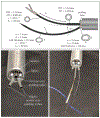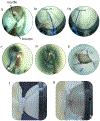Transurethral Anastomosis after Transurethral Radical Prostatectomy: A Phantom Study on Intraluminal Suturing With Concentric Tube Robots
- PMID: 33251487
- PMCID: PMC7694552
- DOI: 10.1109/tmrb.2020.3034735
Transurethral Anastomosis after Transurethral Radical Prostatectomy: A Phantom Study on Intraluminal Suturing With Concentric Tube Robots
Abstract
Current surgical approaches to radical prostatectomy are associated with high rates of erectile dysfunction and incontinence. These complications occur secondary to the disruption of surrounding healthy tissue, which is required to expose the prostate. The urethra offers the least invasive access to the prostate, and feasibility has been demonstrated of enucleating the prostate with an endoscope using Holmium laser, which can itself be aimed by concentric tube robots. However, the transurethral approach to radical prostatectomy has thus far been limited by the lack of a suitable means to perform an anastomosis of the urethra to the bladder after prostate removal. Only a few intraluminal anastomotic devices currently exist, and none are small enough to pass through the urethra. In this paper we describe a new way to perform an anastomosis in the small luminal space of the urethra, harnessing the dexterity and customizability of concentric tube manipulators. We demonstrate a successful initial proof-of-concept anastomosis in an anthropomorphic phantom of the urethra and bladder.
Keywords: Concentric Tube Robots; Minimally-Invasive Surgery; Natural Orifice Surgery; Transurethral Suturing.
Figures





References
-
- Siegel RL, Miller KD, and Jemal A, ”Cancer statistics 2020”, CA: A Cancer Journal for Clinicians, vol. 70, no. 1, pp. 7–30, 2020. - PubMed
-
- Haglind E, Carlsson S, Stranne J, Wallerstedt A, Wilderäng U, Thorsteinsdottir T, Lagerkvist M, Damber J, Bjartell A, Hugosson J, Wiklund P, and Steineck G, “Urinary incontinence and erectile dysfunction after robotic versus open radical prostatectomy: a prospective, controlled, nonrandomised trial”, European Urology, vol. 68, no. 2, pp. 216–225, 2015. - PubMed
-
- Humphreys MR, Sauer JS, Ryan AR, Leslie KO, Castle EP, Lingeman JE, and Andrews PE. ‘Natural orifice transluminal endoscopic radical prostatectomy: initial perioperative and pathologic results”, Urology, vol. 78, no. 6, pp. 1211–1217, 2011. - PubMed
-
- Humphreys M, Krambeck A, Andrews P, Castle E, and Lingeman J. “Natural orifice translumenal endoscopic surgical radical prostatectomy: Proof of concept”, Journal of Endourology, vol. 23, no. 4, pp. 669–675, 2009. - PubMed
-
- Krambeck AE, Humphreys MR, Andrews PE, and Lingeman JE. ‘Natural orifice translumenal endoscopic surgery: radical prostatectomy in the canine model”, Journal of endourology, vol. 24, no. 9, pp. 1493–1496, 2010. - PubMed
Grants and funding
LinkOut - more resources
Full Text Sources
